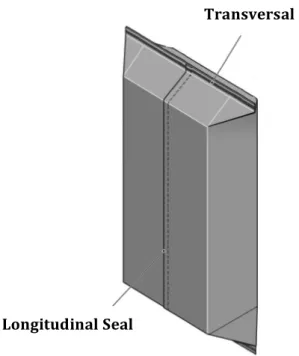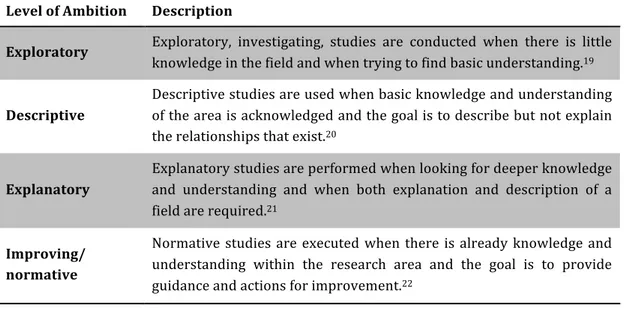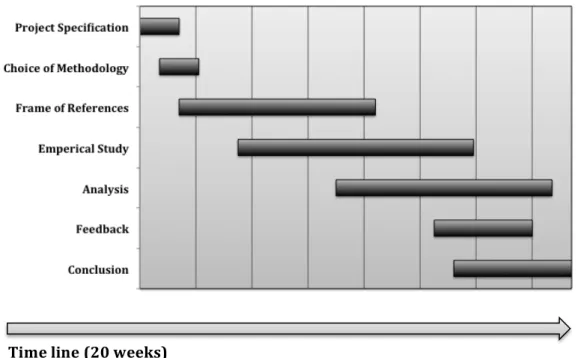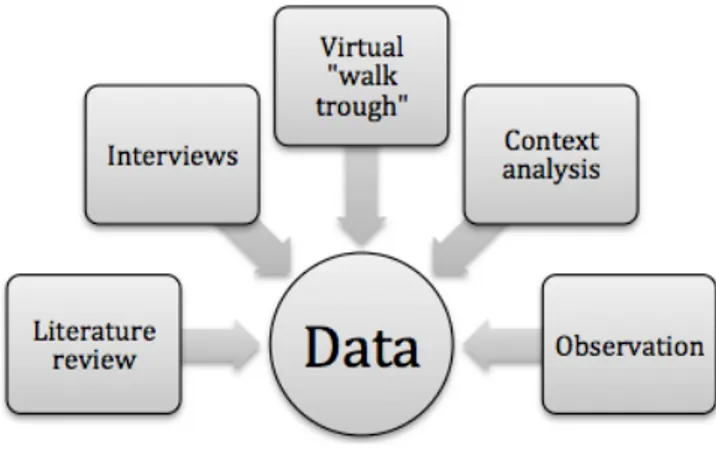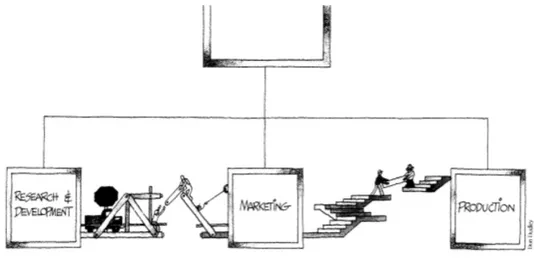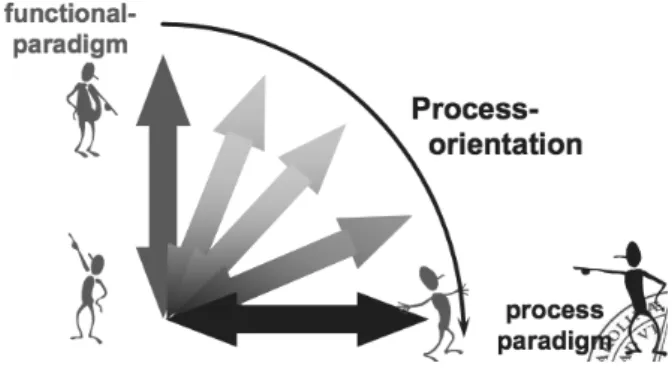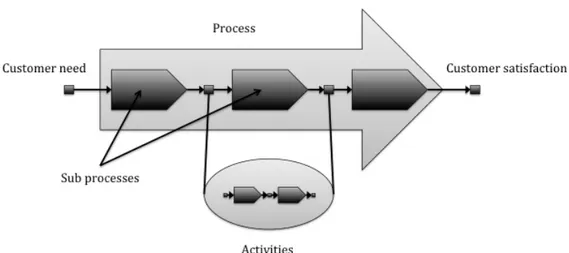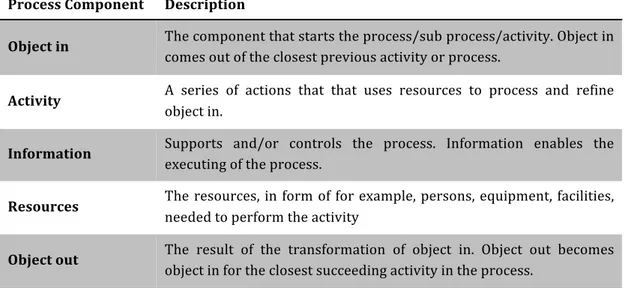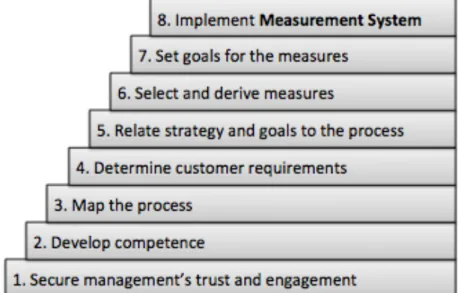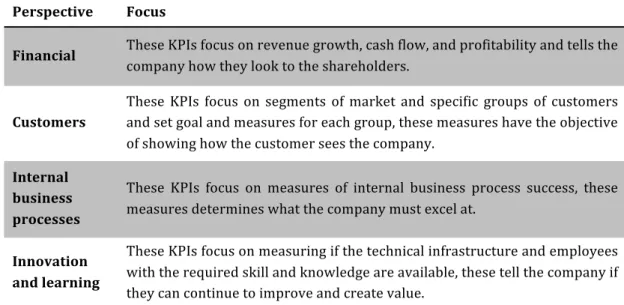Department of Industrial Management and Logistics Division of Production Management
Process for Developing (Sealing) Sub Systems
- An Analysis of the New Product Introduction Process at
Sealing Technology, Tetra Pak
Lund, 2012-02-28Author: Charlotte Carlquist
Supervisors: Bertil I Nilsson, Faculty of Engineering
Henrik Widestadh, Tetra Pak
L
UND UNIVERSITY
Preface
This master thesis was written during the winter of 2011/2012 as the final part of my, almost five year long, master’s degree in Mechanical Engineering at Lund University, Faculty of Engineering. Process orientation, process management and process improvement are new and central ideas in today’s businesses. It has been interesting to have had the opportunity to see how a worldwide company works with these matters. The experience has been exciting, intensive and, most of all, fun. I hope that the reader will be able to learn from my effort.
I would like to express my gratitude to my supervisors for providing me with expertise and support. First of all thank you Henrik Widestadh, supervisor at Tetra Pak, for your kindness and guidance during, not only this thesis, but throughout the last years of my education. Thank you Bertil I Nilsson, supervisor at Lund University, Faculty of Engineering for your time and meaningful advice. Your comments, I think, influenced my work and contributed to a better outcome.
Lund, 2012-‐02-‐28 Charlotte Carlquist
Abstract
Title Process for developing (Sealing) sub systems – an analysis of the New Product Introduction process at Sealing Technology, Tetra Pak.
Author Charlotte Carlquist
Supervisors Henrik Widestadh, Manager Induction Heating, Tetra Pak
Bertil I Nilsson, Adjunct Assistant Professor, Department of Industrial Management and Logistics, Faculty of Engineering, Lund University
Background Sealing Technology is a function under Key Competences at Tetra Pak that develops integrated end-‐to-‐end sealing solutions. Quality improvement is on the agenda and has been on the agenda for a couple of years. The importance of process management has been acknowledged, and a process for developing (Sealing) sub systems has been established. There is a need to evaluate the process map and the process as well as provide plans for how to assure the process quality.
Purpose The purpose of this master thesis is to understand the New Product Introduction process and evaluate it, find potential improvement areas and suggest further efforts to ensure the quality of the process. Recommendations of efforts and how to continuously improve will be presented.
Method
A Systems approach was used to comprehend the complex situation and to guarantee a holistic view of the studied settings. The data was mainly qualitative and four different methods for gathering data were used: interviews, observations, literature review and content analysis. Based on the findings a review of the New Product Introduction process was made to meet the purpose of the project.
Conclusion The review of the New Product Introduction process has resulted in the conclusion that the New Product Introduction process describes an efficient developing process and it is an improvement of how the development was performed before the process was created. However, a part of the interviewed employees does not follow the new process, and this for different reasons. There is a gap between where Sealing Technology is at the moment and where they wish to be, and where the author visions them
to be in the future. Therefore areas of focus have been chosen to help Sealing Technology on their way to process excellence. The areas of focus are process orientation, objective and goal, implementation, process measurement and process evaluation and continuous improvements. These will be presented further and discussed in chapter 7, results and recommendations.
Keywords Process Management, Process Measurement, Quality Management, Business Excellence, Change Management.
Contents
1
INTRODUCTION ... 1
1.1
TETRA PAK ... 1
1.1.1
Sealing Technology ... 2
1.2
PROBLEM DESCRIPTION ... 3
1.3
PURPOSE AND GOAL ... 4
1.4
FOCUS AND DELIMITATIONS ... 5
1.5
TARGET GROUP ... 5
1.6
STRUCTURE OF THE THESIS ... 5
2
METHODOLOGY ... 7
2.1
SCIENTIFIC PARADIGMS ... 7
2.1.1
Analytical approach ... 7
2.1.2
Systems approach ... 8
2.1.3
Actorʼs approach ... 8
2.2
RESEARCH METHODOLOGY ... 8
2.2.1
Strategy of research ... 9
2.3
DATA COLLECTION ... 10
2.3.1
Interviews ... 11
2.3.2
Observation ... 12
2.3.3
Literature review ... 13
2.3.4
Content analysis ... 13
2.4
QUALITATIVE OR QUANTITATIVE RESEARCH APPROACH ... 14
2.4.1
Quantitative ... 14
2.4.2
Qualitative ... 14
2.5
DATA ANALYSIS APPROACH ... 15
2.5.1
Induction ... 15
2.5.2
Deduction ... 15
2.5.3
Abduction ... 15
2.6
EVALUATING THE RESEARCH ... 16
2.6.1
Trustworthiness ... 16
Credibility ... 16 Transferability ... 16 Dependability ... 17 Conformability ... 17 2.6.2
Authenticity ... 17
3
FRAME OF REFERENCE ... 19
3.1
PROCESS MANAGEMENT ... 19
3.2
PROCESSES ... 20
3.3
PROCESS ORIENTATION ... 21
3.4
PROCESS IDENTIFICATION ... 22
3.5
PROCESS DOCUMENTATION ... 23
3.5.1
Process mapping ... 23
3.6
DEVELOPING A NEW MEASUREMENT SYSTEM ... 26
3.7
MEASURING PROCESSES ... 27
3.7.1
Balanced Scorecard approach ... 28
3.7.2
ISO Standard ... 29
3.7.3
The Business Excellence Model ... 32
3.7.4
MBNQA Excellence Model ... 33
3.8
LITERATURE REVIEW OF PROCESS IMPROVEMENT/REDESIGN ... 36
3.8.1
Planning for a process improvement effort ... 36
3.8.2
Mapping existing process ... 36
3.8.3
Analysis of existing process ... 38
3.8.4
Design of a new improved process ... 40
3.8.5
Managing the transition to a new improved process ... 40
3.8.6
Process improvement/redesign vs. process reengineering ... 41
3.9
ADVANCED PRODUCT QUALITY PLANNING ... 43
The five phases of APQP ... 44
3.10
LEAN ... 48
3.10.1
Eliminate waste ... 49
3.11
CHANGE MANAGEMENT ... 51
3.11.1
The eight-stage process for major change ... 51
4
EMPIRICS - DESCRIPTION ... 55
4.1
TETRA PAKʼS GLOBAL MANAGEMENT SYSTEM ... 55
4.1.1
Tetra Pakʼs view on process orientation and process definition ... 55
4.1.2
Tetra Pakʼs Process Levels ... 56
4.1.3
Global Processes ... 56
Product Creation ... 56
4.1.4
Primary Processes ... 56
Product Development ... 57
4.1.5
Process roles ... 57
4.2
TETRA PAKʼS GLOBAL MEASUREMENT SYSTEM ... 57
4.2.1
Global Process Key Performance Indicators (KPIs) ... 58
Global KPIs for the Global Process Product Creation ... 59
4.3
PROCESS IMPROVEMENT EFFORTS ... 59
4.3.1
Internal audit – process reviews ... 59
4.4
THE NEW PRODUCT INTRODUCTION PROCESS ... 59
4.4.1
Process measures and process improvement efforts ... 60
4.4.2
New Product Introduction and Product Development ... 60
4.5
PHASES IN THE NPI PROCESS ... 60
4.5.1
Concept definition ... 61
4.5.2
Concept phase ... 62
4.5.3
Verification phase ... 62
4.5.5
Deployment phase ... 63
4.6
PRODUCT QUALITY MANAGEMENT (PQM) ... 63
4.6.1
Activity Planner ... 64
4.6.2
Drawings, Document System, Manufacturing, Management ... 65
4.7
MEETINGS DURING THE NPI PROCESS ... 66
4.7.1
Internal Design Review Meeting (DRM) ... 66
4.7.2
Internal Technical Review Meeting (TRM) ... 66
4.7.3
Release Forum ... 66
4.7.4
Engineering Change Meeting (ECM) ... 67
5
EMPIRICS – DISCUSSION ... 69
5.1
NEW PRODUCT INTRODUCTION PROCESS “AS-IS” ... 69
5.1.1
Implementation ... 69
5.1.2
Objectives and goals ... 70
5.1.3
People and resources ... 70
5.1.4
Process and process map ... 71
6
ANALYSIS ... 73
6.1
STATE OF SCIENCE VERSUS STATE OF ART ... 73
6.1.1
Process orientation at Sealing Technology ... 73
6.1.2
Developing the NPI process ... 74
6.1.3
Process vs. reality ... 75
6.1.4
Process measurement ... 76
6.1.5
Process evaluation and continuous improvement ... 78
7
RESULT AND RECOMMENDATIONS ... 81
7.1
IMPROVEMENT PROPOSALS ... 82
7.2
BENEFITS DERIVING FROM THE IMPROVEMENT PROPOSALS ... 85
8
CONCLUSION ... 87
8.1
DISCUSSION REGARDING THE RESEARCH ... 87
8.2
PROPOSAL FOR FUTURE WORK ... 87
8.3
CONCLUSION ... 88
9
REFERENCES ... 89
10
APPENDIX ... I
List of Tables
TABLE 1.LEVEL OF AMBITION/STRATEGY FOR RESEARCH. ... 9
TABLE 2.TYPES OF PROCESSES. ... 23
TABLE 3.DESCRIPTION OF THE COMPONENTS OF A PROCESS. ... 25
TABLE 4.THE FOUR PERSPECTIVES OF THE BALANCED SCORECARD APPROACH. ... 28
TABLE 5.THE ELEMENTS OF THE EFQMBUSINESS EXCELLENCE MODEL. ... 34
TABLE 6.THE CRITERIA FOR THE MBNQA EXCELLENCE MODEL. ... 35
TABLE 7.AN EXAMPLE OF AN APQP CHECKLIST AT ELECTROLUX. ... 47
List of Figures
FIGURE 1.LONGITUDINAL AND TRANSVERSAL SEALING. ... 3
FIGURE 2.TIME LINE CONTAINING THE SEVEN PHASES OF THE MASTER THESIS. ... 10
FIGURE 3.THE DATA COLLECTIONS METHODS USED TO CREATE DATA. ... 11
FIGURE 4.THE MANAGING OF “WHITE SPACE” BETWEEN FUNCTIONS. ... 20
FIGURE 5.PROCESS ORIENTATION – A CHANGE IN PARADIGM. ... 22
FIGURE 6.A PROCESS AND ITS SUB PROCESSES AND ACTIVITIES. ... 24
FIGURE 7.THE COMPONENTS OF A PROCESS. ... 24
FIGURE 8.MODEL FOR DEVELOPING A NEW MEASUREMENT SYSTEM. ... 26
FIGURE 9.MODEL OF A PROCESS-BASED QMS. ... 30
FIGURE 10.EXTENDED MODEL OF A PROCESS-BASED QMS. ... 31
FIGURE 11.THE PRODUCT QUALITY PLANNING CYCLE. ... 44
FIGURE 12.THE APQP SYSTEM. ... 45
FIGURE 13.THE “4P” MODEL OF THE TOYOTA WAY. ... 49
FIGURE 14.THE EIGHT-STAGE PROCESS FOR MAJOR CHANGE. ... 54
FIGURE 15.INDICATOR OF HOW WELL THE KPIS MEET THEIR TARGET. ... 59
FIGURE 16.THE FIVE PHASES OF THE NEW PRODUCT INTRODUCTION PROCESS. ... 61
FIGURE 17.THE PQM WEBSITE WITH THE FIVE DIFFERENT MODULES. ... 64
FIGURE 18.VISUAL MANAGEMENT VIEW IN ACTIVITY PLANNER. ... 65
FIGURE 19.TETRA PAKʼS INTERNAL ILLUSTRATION OF PERFORMANCE. ... 82
FIGURE 20.THE AREAS OF FOCUS FOR SEALING TECHNOLOGY. ... 82
1 I
NTRODUCTION
This first chapter is a background to the master thesis and will introduce the reader to the studied company, Tetra Pak, and also to the defined problem. The purpose of the thesis will be described followed by the focus and the delimitations and the target group. To conclude, the structure of the report is presented to provide the reader with an overview.
1.1 Tetra Pak
Tetra Pak are specialists in complete solutions for the processing, packaging and distribution of beverage and food products and are present in more than 170 countries around the world.1 In 2010 74000 million of litres were packed in 158001
million of Tetra Pak packages.2 Tetra Pak ‘s vision describes what they are trying to
accomplish:
“We commit to making food safe and available, everywhere.“3
The solutions that Tetra Pak creates are designed to be as efficient with resources as possible. Dairy products, juices and nectars, ice cream, cheese, dry foods, fruits, vegetables and pet food are examples of products that can be processed or packaged in Tetra Pak processing and packaging lines.
The Tetra Pak mission is:
“We work for and with our customers to provide preferred processing and packaging solutions for food. We apply our commitment to innovation, our understanding of
consumer needs and our relationships with suppliers to deliver these solutions, wherever and whenever food is consumed. We believe in responsible industry leadership, creating profitable growth in harmony with environmental sustainability
and good corporate citizenship.”4
Tetra Pak core values, which have been a part of the spirit since the very beginning, form and shape the essence of the company culture and keep everybody together as a team and reaffirm what Tetra Pak stands for everywhere in the world. The core values provide an aspiration for the future and they are verbalized as5:
1
Tetra Pak International website. The company, retrieved 2011-‐10-‐03.
2Tetra Pak International website, Facts and figures, retrieved 2011-‐10-‐03.
3Tetra Pak International website. Vision and mission, retrieved 2011-‐10-‐03.
4Ibid.
Customer focus & long-‐term view
We ensure we add value and inspire our customers because we recognize that they come to us by choice. We dare to lead with a focus beyond tomorrow and take opportunities to learn and grow.
•
Quality & innovationWe do not compromise on quality. We relentlessly drive for better, fit-‐for-‐ purpose solutions and breakthrough innovations.
•
Freedom & responsibilityWe have a freedom to take initiative and act decisively in the best interests of Tetra Pak and our customers. We take responsibility for our actions and contribute to the communities in which we operate.
•
Partnership & funWe respect and rely on one another and all our stakeholders for exceptional results. We enjoy working together and celebrating our achievements.
1.1.1 Sealing Technology
Sealing Technology is a function under Key Competences, Packaging Technology, Development & Service Operations at Tetra Pak. It is one of three key competences; the other two are Aseptic and In-‐line Plastic Moulding Technologies.
Sealing Technology has around 50 employees that are situated in Lund, Sweden and Modena, Italy. The function is divided into four groups: Sealing Systems, Induction Heating, Sealing Integration and Ultra Sonic & Impulse Sealing, each group with an own manager. The function is a provider of integrated, end-‐to-‐end sealing solutions to Development & Service Operations. Sealing Technology has the ownership of:
•
Sealing process parameters•
Sub-‐system and components specifications•
Sub-‐system and components validation & verification•
Manufacturing process specifications•
Quality and issue resolutionThe sealing of packages is usually done with an inductor, generating a magnetic field, creating heat that together with power seals the package. Every package is sealed transversally and longitudinally; the two seals are named transversal seal and longitudinal seal, they are presented in figure 1.6 This method has been used for
several years. For every change, in for example package size or machine configurations; a new inductor needs to be developed and often other components such as generators, transformers and dollies needs to be delivered together with this inductor. The process of developing inductors and other sealing components is
very complex. Quality deviations on inductors are considered too high and customers are affected by it.
Figure 1. Longitudinal and transversal sealing.7
Today, development of other technologies are on-‐going and in the future Sealing Technology hope to be able to deliver different sealing solutions and components, and these should fulfil customer requirements.
1.2 Problem Description
A few years ago a project started at Sealing Technology, a quality project with the objective to decrease quality deviations on inductors. Root Causes and failure modes had to be understood to eradicate the problems.
During this project, which is still ongoing, the difficulty with not having a well-‐ defined process was revealed. An initiative to map the process for developing (sealing) components/sub systems started but due to changes in the organization it was not until the beginning of the summer of 2011 that a process map was completed, the process is called New Product Introduction (NPI). A finding during this thesis was that everything was not in place when the process was introduced after the summer of 2011 and the situation at Sealing Technology has been very dynamic during the period of this thesis; the organization changed, a new process
7
Tetra Pak Internal, Book of Competence.
Longitudinal Seal
was introduced and continuous improvements regarding the process and process work were performed. This affected the thesis project and the problem description; therefore the author has divided the problem into two focuses, as presented below. Sealing Technology understands the need of evaluating the process map, and consequently the first focus of this thesis was to evaluate the mapping process and the process map. The problem was divided into two questions:
•
How is development accomplished today, from need to delivered solution? Is this compliant with the NPI process?•
Can the existing process for developing (sealing) sub systems, the NPI process, be improved? How should these potential improvements be implemented? The conclusion that the NPI process map was comprehensive and correct was drawn from interviews; it describes a good way of how to develop (sealing) components at Sealing Technology, this will be described further in chapter 5 and 6. Therefore a second focus, or task was decided upon together with Sealing Technology management. The second focus was to evaluate the process, and find ways to assure the quality of it. The second focus is presented in the questions below:•
How should Sealing Technology assure the quality of the NPI process?•
How should Sealing Technology work with the NPI process in the future?1.3 Purpose and Goal
The purpose of this master thesis was foremost to explore and understand the process for developing (sealing) sub systems. This should include understanding the development of the process and the activities in the process. Secondly, Tetra Pak’s and Sealing Technology’s work with the NPI process should be examined and, together with a review of literature, recommendations of how to evaluate the process and continuously improve it will be provided. The goal of this thesis can be divided into three sub goals:
•
Understand the NPI process and process work at Sealing Technology o Understand today’s development processo Understand the NPI process map and how it was created o Is there a gap between map and process?
•
Develop an action plan for improving the NPI process and improving Sealing Technology’s work with processeso How to close gap between reality and process map? (If such a gap exists.)
o How to secure the quality of the process and to continuously improve? o What to do in the future?
The recommendations for how to work with the NPI process and how to assure the quality of it should be provided in a report together with suggestions for further work to be done.
1.4 Focus and Delimitations
This master thesis is limited to the processes inside of Tetra Pak and therefore other companies cannot use this thesis as a base for their own processes. Within Tetra Pak focus is on the NPI process in Sealing Technology, there will be no review of other processes in the company. Standard documents and other templates that are being used throughout the processes are not to be restructured or upgraded because this is not the focus of the thesis.
1.5 Target Group
The group of which this thesis addresses is foremost managers and personnel working at Sealing Technology, Tetra Pak. However personnel from other development departments at Tetra Pak can also find the thesis interesting. It is also relevant for students at Faculty of Engineering, Lund University and it can be relevant for other manufacturing companies, but the fact that not everything is applicable for them must be pointed out.
1.6 Structure of the Thesis
The thesis has a structured layout and all the chapters are introduced with a concise summary of the content, to simplify for the reader and provide better understanding. The structure of the thesis it displayed below.
Introduction The opening chapter presents the background of the study, the research questions, the purpose of the thesis and the structure of the report.
Methodology This chapter provides a description of the chosen methodology that has been applied in this thesis. An explanation of different approaches of data collection can be found in this chapter. Different ways to evaluate the research will also be discussed.
Frame of References A basis for the theoretical framework is presented in this chapter. Fundamental ideas and concepts are
described such as Process Management, process mapping, Process Measurements, Lean, ISO Standard, and Change Management.
Empirics The empirical study is divided into two chapters, one descriptive and one covering reflections. The descriptive chapter reviews Tetra Pak’s Global Management System and presents the Global Processes that Tetra Pak follows. Also, Sealing Technology’s current development process, the NPI process, will be described comprehensively in the descriptive part, as well as what efforts has been done and will be done regarding this process. The other chapter discusses the reflections regarding the NPI process that was found during interviews.
Analysis In the analysis chapter an analysis, based on both empirical study and the frame of references, of the current process is presented. The identified gaps, inefficiencies is analysed and the potential improvements are pointed out.
Result and This chapter is a summary of the thesis and the results. The areas of focus for improving the situation can be found in this chapter.
Conclusion To conclude the thesis a discussion regarding the research and an evaluation of the research is provided. Also in the chapter suggestions for future work to be performed are presented and a conclusion ends the thesis.
2 M
ETHODOLOGY
This chapter presents the research methodology that is used throughout the thesis and the choice of the methodology is motivated. Different data collection techniques are enlightened. A discussion regarding trustworthiness and authenticity of data concludes this chapter.
2.1 Scientific Paradigms
The scientific approach of the researcher affects the choice of research methodology together with a number of other factors like the nature of the research question. To understand the result of a study it is essential to understand the researcher’s scientific approach, i.e. the researcher’s view of reality.8 The reasoning for this
project was that a case study of the processes for developing (sealing) sub systems at Tetra Pak requires a holistic view to achieve the right results. The different parts of the process, such as the activities, documents, personnel and resources must be examined as a system and therefore a systems approach was used. During the project there will be times when the system is studied from the inside and therefore the actor’s approach will in some cases be used in combination with the systems approach. The next three sections will describe the three different scientific approaches, which were all studied to reach the conclusion of which one to use.
2.1.1 Analytical Approach
The analytical approach suggests that there is an objective reality, in which causal relations and patterns can be studied and revealed through research.9 The whole is
equal to the sum of its parts.10 The researcher should avoid influencing the
researched object, and thus distorting the reality. Therefore the researcher must separate himself/herself from the research object to avoid this from happening. The objective is to uncover patterns and relations to find explanations, generalise the results and predict future incidents. The basic assumption is that the world can be analytically decomposed and that each concept can stand alone. Quantitative data analysis by means of statistical procedures is a method that is frequently used in this approach.11
8
Gammelgaard, B. 2004, “Schools in logistics research? A methodological framework for analysis of the
discipline”.
9
Ibid.
10
Arbnor, I. & Bjerke, B. 1997, “Methodology for Creating Business Knowledge”.
11
Gammelgaard, B. 2004, “Schools in logistics research? A methodological framework for analysis of
2.1.2 Systems Approach
The systems approach states that the world must be understood in terms of mutually dependent components, as a system with parts, links, goals and feedback mechanisms. The sum of the parts does not equal the whole. Therefore splitting reality into parts is pointless. In systems approach the term “holistic” is used as opposed to “atomistic”, however within the boundaries of the system.12 Knowledge
depends on the system and the pursuit for an absolute truth is exchanged by the search for a resolution that works in practise.13 The pragmatism of the systems
approach suggests that the researcher should be very near the research object, to be able to make an impact on the system.14
2.1.3 Actorʼs Approach
This approach views the world completely different than the analytical and systems approach. The reality is not objective and the whole exists only as meaning structures, which are socially constructed and knowledge creation depends on the researcher’s interpretation.15 The approach claims that it is unmanageable to make
prediction built on external cause-‐effect-‐relations of social reality due to human beings’ intentionality. The ultimate objective is to understand and construct the future from within, the researcher being part of the research reality, and primarily via qualitative studies.16
2.2 Research Methodology
Methodology is the basic working method that sets principles and structures for how a study is performed.17 The existing amount of knowledge of the research
object is of importance when choosing which type of study that will be carried out and on what level of ambition.18 The levels of ambition and when they should be
used are described in table 1.
12
Gammelgaard, B. 2004, “Schools in logistics research? A methodological framework for analysis of
the discipline”.
13
Arbnor, I. & Bjerke, B. 1997, “Methodology for Creating Business Knowledge”.
14
Gammelgaard, B. 2004, “Schools in logistics research? A methodological framework for analysis of
the discipline”.
15
Arbnor, I. & Bjerke, B. 1997, “Methodology for Creating Business Knowledge”.
16
Gammelgaard, B. 2004, “Schools in logistics research? A methodological framework for analysis of
the discipline”.
17
Höst, M., Regnell, B. & Runeson, P. 2006, “Att genomföra examensarbete”.
18Wallén, G. 1996, “Vetenskapsteori och forskningsmetodik”.
Table 1. Level of ambition/strategy for research.
Level of Ambition Description
Exploratory Exploratory, investigating, studies are conducted when there is little
knowledge in the field and when trying to find basic understanding.19
Descriptive
Descriptive studies are used when basic knowledge and understanding of the area is acknowledged and the goal is to describe but not explain
the relationships that exist.20
Explanatory
Explanatory studies are performed when looking for deeper knowledge and understanding and when both explanation and description of a
field are required.21
Improving/ normative
Normative studies are executed when there is already knowledge and understanding within the research area and the goal is to provide
guidance and actions for improvement.22
This study will aim at being at a level of ambition that is exploratory but when understanding of the “as-‐is” process is obtained the project will go in to a second phase where the level of ambition will be more improving/normative and where potential improvements and guidance for future will be reviewed.
2.2.1 Strategy of Research
This master thesis follows a time plan that was created to make sure that all parts of the project will be covered. A timeline from project specification to conclusion is presented in figure 2. In the diagram the different phases of the project overlap each other, to show that they are not done in isolation, rather they build on each other. There is an interrelation between the phases, which is not illustrated in the diagram. This means that even though one phase is over they are all still connected, for example findings in literature review will be used in the analysis, and also during the interviews and so on.
19
Wallén, G. 1996, “Vetenskapsteori och forskningsmetodik”.
20Ibid.
21 Ibid. 22
Ibid.
Figure 2. Time line containing the seven phases of the master thesis.
2.3 Data Collection
There are many different sources of information that can be used in research.23
According to Frankel et al. eight frequently used methods for collecting data are; interviews, surveys, observation, focus groups, case studies, experiments, literature reviews, and content analysis. These methods for collecting data is suited for different research issues, there are not one particular technique that is superior to another. To acquire good trustworthy data that is essential for a successful analysis a mixture of different sources of information is preferred.24 The different techniques
of gathering data can be used in combination to complement each other.25
Four methods for collecting data have been used during this thesis to complement each other and to get a good base for analysis; this is illustrated in figure 3. The methods that foremost will be used are interviews, observations, literature reviews and content analysis. They fit the research question and were possible to conduct. A conclusion drawn from several sources of information is stronger than a conclusion
23
Höst, M. & Runeson, P. 2009, “Guidelines for conducting and reporting case study research in
software design”.
24
Ibid.
25
Frankel, R., Näslund, D. & Bolumole, Y. 2005, “The “White Space” of the Logistics Research: A look at
the Role of Methods Usage”. Time line (20 weeks)
based on a single source.26 During the literature review of process redesign and
process improvement other methods for collecting data was suggested, see Section 3.7.2. The method of interviews/virtual “walk trough” will be used in combination with interviews. Data will be gathered from the personnel performing the process, they will describe their part of the process and this is the objective of the interviews. In the coming sections the four methods for data collection will be discussed.
Figure 3. The data collections methods used to create data.
2.3.1 Interviews
Interviews are often designed as personal meetings between an interviewer and respondent(s), but can cover a variety of formats. The benefits of interviews are that they are insightful and provide a perceived causal interference.27 There are three
different types of interviews, unstructured, semi-‐structured and fully structured. In an unstructured interview the interview questions are formulated as general concerns and interests from the researcher.28 The conversation is open, the
interview provides a “depth” and the object is to uncover the underlying beliefs, attitudes, and feelings on a topic.29 The opposite of this is the fully structured
interview where the questions are clearly formulated in the same order for all the respondents. It is similar to a questionnaire-‐based survey. A semi-‐structured
26
Höst, M. & Runeson, P. 2009, “Guidelines for conducting and reporting case study research in
software design”.
27
Frankel, R., Näslund, D. & Bolumole, Y. 2005, “The “White Space” of the Logistics Research: A look at
the Role of Methods Usage”,
28
Höst, M. & Runeson, P. 2009, “Guidelines for conducting and reporting case study research in
software design”.
29
Frankel, R., Näslund, D. & Bolumole, Y. 2005, “The “White Space” of the Logistics Research: A look at
interview is planned, with questions, but it is not essential that all questions are asked and be followed in the same degree as in a fully structured interview.30
The format of the first interviews during this thesis were unstructured to assure a depth, provide a good understanding of the processes and uncover what the respondents really had to say without any influence. The person being interviewed described the part of the process he or she is involved in and provided information about unnecessary activities, and improvement opportunities. If a second round of interviews where performed in a semi-‐structured way to assure that missing information was brought up and discussed. Feedback on the conclusions was made in a structured interview to all the respondents. The respondents for the interviews were chosen in consultation with managers at Sealing Technology, to assure that important employees and key persons from all parts of the development process were represented. In addition to this, some interviews have been performed that were not planned from the beginning, but that were required to understand other parts of the organization. The respondents are listed in the references under interviews; names and positions of the respondents can be found there.
2.3.2 Observation
Observations include documenting the behavioural patterns of people, objects, and events in a methodical way to acquire information about the phenomenon of interest. The observation records are often referred to as field notes. This method assumes that behaviour is purposeful and expressive of deeper values and beliefs. The observer’s role can vary from complete observer to complete participant.31 It is
especially relevant to use observations where it is suspected that there is a deviation between the “official” view of matters and the “actual” case.32 The observation
process is sensitive for the risk that the observer’s perception can be influenced by personal factors and beliefs; the collected data can differ depending on observer.33
To get a deeper understanding of some activities in the process some observations or virtual walk troughs has been conducted. The checkpoint meetings, also known as Release Forum, have been observed to see if and how they support the following of the process. A walk along the production line for inductors and dollies was performed to get an overview of the work being carried out there.
30
Höst, M. & Runeson, P. 2009, “Guidelines for conducting and reporting case study research in
software design”.
31
Frankel, R., Näslund, D. & Bolumole, Y. 2005, “The “White Space” of the Logistics Research: A look at
the Role of Methods Usage”,
32
Höst, M. & Runeson, P. 2009, “Guidelines for conducting and reporting case study research in
software design”.
2.3.3 Literature Review
The review of literature contains a comprehensive analysis and systematic summary of other author’s previously collected data, e.g. secondary data.34 This data collection
method has the advantage of gathering a great share of data within a short amount of time and with little economical resources. This is a way to review existing knowledge and theories concerning a specific area, however it is important to be aware of the fact that the information could be bias and not fully comprehensive.35
The study of literature was extensive and concepts regarding process management were identified. A review of several methods for process mapping, process improvement, process measuring and process analysis has been made. Furthermore, Lean production and Lean thinking has been studied to understand the essentials. To conclude, a review of the field change management was performed to understand the challenges of changing an organization and to be able to use this when recommending implementation of a new process. The search was done based on some key search words, such as, process mapping, proves improvement, process redesign, process change, as well as Lean and change management. Known authors in the different fields where discovered and used as references, for example Michael Hammer and Paul Harmon in process change and John P. Kotter in change management.
2.3.4 Content Analysis
Content analysis can provide a broad coverage of data over an extended time span trough the study of documents, websites and archival records. The data sources can consist of published and unpublished documents, company reports, memos, letters and newspaper articles and so on.36 Knowledge of the history and context
surrounding a specific setting comes, in part, from reviewing documents. Documents from the past must be reviewed with some scepticism. The greatest strength of content analysis is that is unobtrusive and nonreactive, it can be conducted without disturbing the setting in any way.37
Relevant Tetra Pak documents was reviewed, mainly regarding processes and assessment of processes, but also regarding the organization and the objectives and deliverables for Sealing Technology. The managers provided these documents. The internal websites was also studied, as well as the Product Quality Management
34
Frankel, R., Näslund, D. & Bolumole, Y. 2005, “The “White Space” of the Logistics Research: A look at
the Role of Methods Usage”,
35
Björklund, M. & Paulsson, U. 2003, “Seminarieboken – att skriva, presentera och opponera”.
36Frankel, R., Näslund, D. & Bolumole, Y. 2005, “The “White Space” of the Logistics Research: A look at
the Role of Methods Usage”,
(PQM) system and Activity Planner (AP) that handles all activities regarding sealing components.
2.4 Qualitative or Quantitative Research Approach
Research approaches vary from quantitative approach, which is the more scientific, objective one, to qualitative approach, which is the interpretive, subjective and more constructive style. There are advantages and disadvantages with both and usage of them should be based on the problem, because different research problems require different research approaches. When studying the processes of Tetra Pak from the inside, using data collection methods as observations and interviews, the major part of data will be qualitative. The structure of the data collection will be flexible, and not completely fixed from the beginning. This provided a deep understanding of the processes and therefore it is mainly a qualitative research approach that will be used, the two approaches are described in the following two sections.
2.4.1 Quantitative
The quantitative research approach is designed to quantify the gathered data and subsequently statistically generalise it. The intention is to create new knowledge that can be added to existing knowledge and to disregard false hypothesis.38 39
Examples of arguments for quantitative studies are that the results easily can be shown in diagrams and graphs, the reliance through the statistical calculations and the trustworthiness because the analysis is based on objective laws and not the researcher’s value. Awareness of threats, like false pretences that can compromise the objectivity, is essential for good research quality, and to remember a good research require good quality of data.40
2.4.2 Qualitative
Qualitative research approach allows the researchers to study social and cultural phenomena. The style is more subjective and it argues that the world is fundamentally relativistic and therefore one need to understand it from the inside, i.e. from the point of view of the individuals who are directly involved in the activities being studied. 41 Qualitative studies provide excellent and deep
understanding and a holistic view because the data is formed from social settings and it considers the entire situation. Other explanations and contradictory results should always be reviewed to provide more credibility. Gathering and analysing of
38
Denscombe, M. 1988, “A Good Research Guide – for small-‐scale research projects”..
39
Frankel, R., Näslund, D. & Bolumole, Y. 2005, “The “White Space” of the Logistics Research: A look at
the Role of Methods Usage”.
40
Denscombe, M. 1988, “A Good Research Guide – for small-‐scale research projects”.
41
